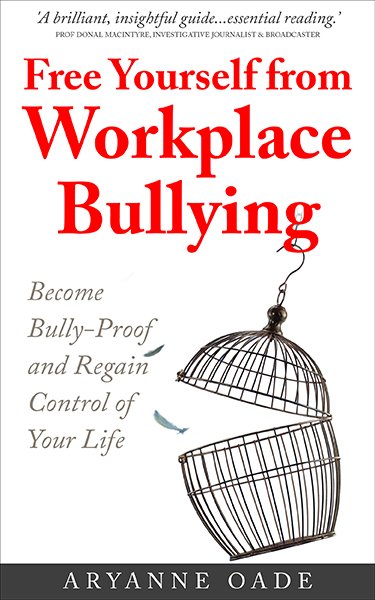How to identify and handle incidents of grooming
By Aryanne Oade
Grooming is the behaviour used by a bully to ascertain whether a possible target will be susceptible to a campaign of workplace bullying. Grooming occurs during the period before a campaign commences. It may occur just once, or over a number of interactions. In each incident of grooming, the bully deliberately uses behaviour which tests the waters to see how their potential target will react. They then carefully observe what the target says and does to make an assessment about whether they will be someone with whom it will be straightforward to create and maintain a bullying dynamic. This is grooming and every workplace bully does it.
It is my belief that anyone can be groomed. People who are assertive and know how to handle confrontation can be groomed; people who don’t like conflict or don’t know how to stand up for themselves can also be groomed. But not everyone will be subject to a campaign of workplace bullying. In many cases, people who have a hard time using assertive behaviour may be the preferred targets for workplace bullies because their responses at the time of being groomed leave them vulnerable.
In this article we will explore:
- The dynamics at play in an incident of workplace grooming.
- Some examples of workplace grooming.
- How to respond effectively to grooming behaviour.
The Dynamics of Workplace Grooming
Grooming can involve subtle and confusing behaviour or it can involve direct and obvious behaviour. But however they go about it, a workplace bully has one aim in mind: they want to assess how a target will react when they are groomed. Specifically, they are likely to form a judgement in terms of:
- How the targets responds to their grooming: confidently, uncomfortably or somewhere in between.
- The degree to which the target successfully sends back a clear message that they are neither intimidated nor confused, and know how to take care of themselves.
Examples of Grooming Behaviour
- A newly appointed construction worker walks onto site for his first morning’s work. The new worker is friendly and outgoing, used to establishing liking and rapport with his workmates. He sees the foreman approaching him and smiles, but is surprised by the response he gets. The foreman, a tall man with an impassive face, looks down at him and, without breaking step, tells him brusquely that he ‘better not step out of line’ before pushing him out of his way as he brushes past him. The foreman’s behaviour is designed to test the resolve of the new site worker. It gives the foreman the opportunity to observe his new recruit and evaluate how susceptible he might be to escalating attacks.
- One administrative assistant turns towards another administrative assistant and, in a sneering and openly scornful tone, instructs her to ‘clear up that appalling mess’ while pointing to a pile of her own paperwork which she has left strewn about on the floor of their joint office. This grooming is aggressive and directive, a combination which will provide the bullying assistant with much useful information about the way her colleague reacts under this kind of pressure.
In any incident of successful workplace grooming, the colleague subject to grooming behaviour mishandles the moment because they:
- Don’t recognise the grooming behaviour for what it is.
- Feel confused and don’t ask the obvious question.
- Feel intimidated and don’t protect their boundaries in response to the aggression or intimidation.
- Don’t want to face up to the challenging dynamics they find themselves in, and remain silent and submissive when they really need to engage.
Responding Effectively to Workplace Grooming
Just like the two characters above, the very fact that a target feels confused in the moment of being groomed is the signal that they need to act. They mustn’t hesitate, but need to seize the moment, find something to say, and avoid remaining passive and silent. The very fact of articulating a clear and relaxed response will change the dynamic evolving between the target and the bully, and send a message to the bully that the target knows what they are doing and knows how to protect themselves. What they say, as well as how they say it, is important too. The target’s aim in responding is to create consequences for the bully to deal with in the moment, rather than leaving all of the confusion and anxiety with themselves. They could:
- Ask the bully what they mean if they have said something misleading, opaque or indirect.
- Directly disagree with them to demonstrate that they know their own mind.
Let’s return to the two examples:
- The new site worker could address the retreating back of the foreman, and in a clear and firm tone say: ‘What do you mean?’ or ‘You just brushed past me. What do you mean by that?’ The foreman now has to explain himself. He may back down; or he may choose to confront again, perhaps with more outright aggression, in which case the site worker has a choice to make: does he remain and contest with the foreman at every turn or does he make an early decision to handle this situation in another way?
- The administrative assistant could simply hold her ground, turn to face her bullying colleague and say: ‘That is your mess to clear up’ before going back to her work. Carrying on with her duties – in other words, handling herself as usual – will be a powerful message that she and she alone decides what she does, and that she does not give in to intimidation.
When a target has successfully defended themselves against an incident of grooming, be aware that the would-be bully may well try again to test their resolve and resilience. If they do, the target needs to use exactly the same approach: putting the issues back to the bully without being rude or disrespectful. They need to simply draw the line and keep doing it until the bully gets the message and ceases grooming them.
This is the first of three articles in a series on bullying behaviour in the workplace. Subsequent articles will explore passive and active aggression, and how authority issues play out in upwards bullying.

 Aryanne Oade has worked as a chartered psychologist for over twenty years. She coaches clients to recover from the debilitating effects of workplace bullying, and to re-discover their energy and enthusiasm. Aryanne is the bestselling author of seven books. www.oadeassociates.com
Aryanne Oade has worked as a chartered psychologist for over twenty years. She coaches clients to recover from the debilitating effects of workplace bullying, and to re-discover their energy and enthusiasm. Aryanne is the bestselling author of seven books. www.oadeassociates.com
This article contains extracts from Aryanne’s latest best-selling book: Free Yourself from Workplace Bullying: Become Bully-Proof and Regain Control of Your Life. Visit www.minthallpublishing.com to order paperback copies at a discount, or buy smaller quantities and the eBook from Amazon.
What makes us susceptible to burnout?
In this episode of the Safety & Health Podcast, ‘Burnout, stress and being human’, Heather Beach is joined by Stacy Thomson to discuss burnout, perfectionism and how to deal with burnout as an individual, as management and as an organisation.
We provide an insight on how to tackle burnout and why mental health is such a taboo subject, particularly in the workplace.




Readers who would like to explore issues around workplace bullying further can download a range of free audio and written resources on detoxifying and recovering from bullying, learning to become bully-proof and handling adversarial behaviour at work:
http://www.oadeassociates.com/downloads/
The two examples you have given are not subtle. In my experience, the highly manipulative bully is covert in their behaviour and passive aggressive in their nature. They can be very charming in their initial interactions with you until they ‘hook’ you – this is when the bully has built up a level of trust so that he or she can control and you have been groomed before you know it. Then the cracks will start to show with their passive aggressiveness. You are not sure how to take their comments because up until now they have been nothing but… Read more »
I knew someone of the sort, only the individual did not engage in bullying behavior towards me, he was however very outgoing and engaging, while I always kept to myself. Turns out he was a thief, and the kind of work we engaged in provided ample opportunity for him. I always realized that an individual who had something go missing suspected me, and would not stop to consider the actual culprit. I distanced myself, and was warned by someone I trusted not to mention what the thief was doing, because I was advised that it was likely no one would… Read more »